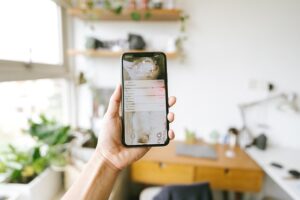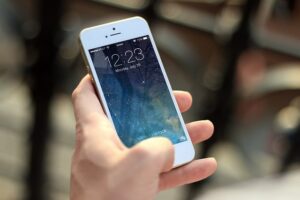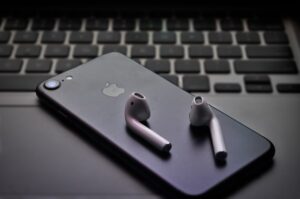If you encounter the “Liquid Detected in Lightning Connector” alert on your iPhone while trying to charge it, there’s no need to worry. This is a common alert that indicates moisture has been detected in the charging port.
To resolve this issue, you simply need to wait until the lightning port air dries completely. During this time, you can still use your phone for other functions, but you won’t be able to charge it using a lightning cable until the port is fully dry.
In the meantime, if you need to charge your iPhone, you can use a cordless charger (wireless charger) that doesn’t require plugging into the lightning port. This will allow you to charge your phone while waiting for the port to dry out.
It’s important not to force a connection or use any objects to try and remove the moisture from the port, as this could potentially cause damage. Just allow the port to dry naturally, and you should be able to resume normal charging once it’s completely dry.
Remember, this alert is just a safety measure to prevent any potential damage to your phone, and it’s not something to be alarmed about.
Liquid in the lightning connection means what?
You are correct! The “lightning connector” is simply another term for the charging port on your iPhone.

When you see the “Liquid Detected in Lightning Connector” alert, it means that either your iPhone’s charging port or the lightning charging cable has become wet or moist.
There are various ways this moisture can accumulate, some of the most common being:
- Leaving your iPhone in the bathroom while taking a shower, where the high humidity can cause moisture buildup inside the charging port.
- Getting caught in the rain or being exposed to water, leading to your phone getting wet.
- Accidentally jumping into a pool with your phone in your pocket, resulting in water damage.
- Spilling a drink like coffee or water on your iPhone, causing it to become wet.
Now, you might wonder whether your iPhone is water-resistant and whether that should protect it in such situations.
It’s important to note that not all iPhone models are fully water-resistant. While newer models tend to have better water-resistant capabilities, they are not entirely waterproof. Water-resistant iPhones are designed to handle minor splashes and accidental exposure to water, but they are not meant to be submerged in water or exposed to excessive moisture for extended periods.
If you see the “Liquid Detected in Lightning Connector” alert, it’s essential to avoid trying to charge your iPhone until the moisture has fully dried out. Attempting to charge your phone while it’s wet could potentially cause damage.
To dry your phone, you can gently pat it dry with a soft cloth or towel and leave it in a dry, well-ventilated area for some time. It’s generally recommended to wait at least a few hours or even overnight before attempting to charge your iPhone again.
If your iPhone has water-resistance capabilities, the moisture detection feature is a safety measure to prevent damage from occurring due to charging while wet. However, it’s essential to take appropriate care when dealing with moisture to ensure the longevity and proper functioning of your device.
What if my iPhone is waterproof?
Apple’s current lineup of iPhones, including the iPhone 8 and later models, is indeed water-resistant. This means they have certain protective measures in place to withstand exposure to water and minor splashes.
However, it’s important to understand that being water-resistant does not make the iPhone completely impervious to liquid damage. While water-resistant iPhones can handle accidental spills, rain, or brief immersion in water to some extent, they are not designed to be fully waterproof.

The internal components of the iPhone, including the metal pins inside the lightning port, can still be susceptible to corrosion and damage if they come into contact with liquids. The water-resistant feature aims to protect the device under normal conditions, but extreme or prolonged exposure to liquids can still pose a risk.
To prevent any potential damage to the phone’s internal components, Apple has implemented safety mechanisms like disabling the lightning connector when the phone detects liquid in the charging port. This action prevents any electrical current from passing through the metal pins, reducing the risk of corrosion and potential damage to the connector strip.
While the water-resistant feature adds a layer of protection, it’s essential to handle your iPhone with care, especially in wet environments. If your iPhone displays the “Liquid Detected in Lightning Connector” alert, it’s best to allow the charging port to air dry before attempting to charge the phone again. This precaution can help avoid any potential damage caused by charging while the port is still wet.
In summary, having a water-resistant iPhone is a great feature for everyday use and accidental exposure to water. However, it’s crucial to remember that it’s not fully waterproof, and taking appropriate care to prevent prolonged exposure to liquids is essential to ensure the longevity and proper functioning of your device.
What to do if a lightning connector has liquid?
It is highly advisable to avoid using the “Emergency Override” option and instead, allow your iPhone sufficient time to dry naturally. Ignoring the alert and selecting “Dismiss” should not cause any additional damage, as long as you refrain from plugging any cables or accessories into the charging port.

To ensure there is no lasting damage and to get your phone working again, you can follow these steps:
- Unplug any cables or accessories connected to your iPhone.
- Hold your iPhone with the Lightning port facing down and firmly tap your phone with the palm of your hand to help remove any liquid from the port.
- Place your iPhone in an open, ventilated, and dry area.
- Wait for a minimum of 30 minutes before attempting to charge your device again.
If you continue to see the “Liquid Detected in Lightning Connector” alert, it is possible that there is still liquid residue beneath the Lightning pins. In such cases, it is best to wait for at least another 30 minutes before attempting to charge the iPhone again.
It is essential to be patient during this process. The drying time can vary depending on the amount of liquid present and the environmental conditions. In some instances, it may take up to 24 hours before the alert disappears, and your iPhone is fully dry and operational again.
Remember that water resistance is a protective feature but not a guarantee against liquid damage. Taking precautionary steps and allowing your iPhone adequate time to dry is crucial to minimize the risk of any long-term damage and to ensure the proper functioning of your device.
In conclusion, patience is key when dealing with liquid in the Lightning connector, and following these steps can help protect your iPhone and prevent any potential issues.
Cordless charging
If you have a cordless charger (also known as a wireless charger), you can use it to charge your iPhone while you wait for the lightning port to dry out fully. This is a great alternative that allows you to continue using and charging your phone without needing to plug in a cable.
In your case, when your iPhone fell in the tub and triggered the “Liquid Detected in Lightning Connector” warning, you were able to use the cordless charger later that day, and it worked perfectly. The next day, your phone was fully dry, and the lightning charger started working again.
Having a cordless charger is especially handy in situations like this, as it allows you to maintain functionality without worrying about the wet charging port. The cordless charger uses magnetic induction to transfer power to your iPhone, eliminating the need for physical connections.
Apple’s MagSafe charger is one such cordless charger specifically designed for iPhone 8 and later models. It ensures a secure and efficient charging experience. However, there are also many third-party cordless chargers available on platforms like Amazon that are compatible with iPhone 8 and later models.

It’s important to note that cordless charging is supported only on iPhone 8 and newer models, as the older models do not have the necessary hardware for wireless charging.
In conclusion, having a cordless charger is a convenient solution when dealing with liquid in the lightning port, allowing you to use and charge your iPhone without worrying about the port’s moisture. It provides a seamless charging experience and can be beneficial in situations where the lightning port may need some time to dry out fully.
When liquid has been found in a lightning connector, what not to do?
When dealing with a liquid-damaged iPhone, it’s crucial to avoid certain common practices that may cause further damage to the device. Despite the temptation to speed up the drying process, it’s best to exercise patience and let the iPhone air dry naturally. Here are the things to avoid:
- Do not use rice or silica gel packets: Putting your iPhone in a container of rice or silica gel packets is a common myth that has been debunked. This method does not effectively remove moisture from the internal components of the device and can even lead to dust or particles getting inside the device.
- Avoid using a heat source: Using a heat source, such as a radiator or hair dryer, to dry your iPhone is another common misconception. Exposing the device to heat can cause internal components to expand and may damage sensitive parts. It’s best to let the phone dry at room temperature.
- Don’t insert objects into the Lightning port: Trying to remove moisture from the Lightning port using items like Q-tips or napkins is not recommended. This can push the liquid further inside the device or cause damage to the port’s delicate pins.
The best approach is to follow the steps we mentioned earlier: unplug any cables or accessories, gently tap the phone to encourage liquid to come out, place it in an open and dry area, and wait at least 30 minutes before attempting to charge it again.
Being patient and allowing the phone to air dry is the safest and most effective way to handle liquid damage. Trying to rush the process with unverified methods can potentially lead to permanent damage and void any warranty coverage.
If the “Liquid Detected in Lightning Connector” alert persists after adequate drying time, it may be a sign of lingering moisture or residue inside the port. In such cases, it’s best to contact Apple Support or visit an authorized service center for further assessment and repair.
When to override the liquid detection alert
While it’s true that there may be emergency situations where you need to charge your wet iPhone and decide to override the liquid detection alert, it’s crucial to understand the risks involved. Overriding the alert can indeed potentially damage your device permanently since water and electricity do not mix well.
If you find yourself in such an emergency, follow these steps with caution:
- First, ensure that the outside of your iPhone is completely dry.
- Consider using a wireless charger instead of a wired one. Wireless charging eliminates the risk of damaging the charging port since there are no exposed electrical contacts.
- If you still need to charge your iPhone using a wired connection, reconnect the lightning cable or accessory shortly after the liquid detection alert appears.
- When the alert pops up again, tap the “Emergency Override” button.
Again, I must emphasize that while this emergency override might allow you to charge your iPhone, it significantly increases the risk of causing permanent damage to your device. The safest approach is to let your iPhone air dry naturally and use a wireless charger if available.
If the “Liquid Detected in Lightning Connector” alert persists after using the emergency override or after proper drying, it’s best to wait until the device is fully dry or seek professional help from Apple Support or an authorized service center to avoid potential harm to your iPhone.
Emergency override not working
You are correct; using the “Emergency Override” may sometimes allow you to charge your iPhone successfully, but in some cases, it may not resolve the issue. If you encounter this problem, there are a few steps you can take to try and fix or avoid it:

- Hit “Dismiss” and force restart your iPhone: To force restart your iPhone, quickly press and release the volume up button, then quickly press and release the volume down button, and finally, press and hold the side button until you see the Apple logo on the screen. This may help reset any glitch that caused the charging issue.
- Use genuine Apple chargers: As you mentioned, aftermarket chargers might trigger the liquid detection alert. Using genuine Apple chargers and cables can help avoid potential compatibility issues.
- Charge wirelessly using MagSafe: If your iPhone supports MagSafe charging, consider using a wireless charger like MagSafe to avoid any problems with the charging port. Wireless charging eliminates the need to use a wired connection and reduces the risk of damaging the charging port due to moisture.
If you’ve tried the above steps and the charging issue persists, it’s possible that there might be an underlying hardware problem with your iPhone’s charging port. In such cases, it’s best to contact Apple Support or visit an authorized service center for further assistance and potential repairs.
What to do if iPhone detects liquid when it’s dry
Sometimes, the liquid detection alert may persist even when you are sure your iPhone and Lightning connector are dry. In such cases, it’s a good idea to inspect the Lightning port for any dust or debris that might be triggering the alert. Here’s what you can do:
- Get a flashlight and inspect the Lightning port: Shine a light into the port and check for any visible dust, lint, or debris that could be obstructing the metal pins.
- Clear out any obstructions: If you find any debris, use compressed air to gently blow away the dust and particles. Be careful not to use any sharp objects that might damage the metal pins.
- Recheck for the liquid detection alert: After cleaning the port, recheck to see if the liquid detection alert persists. If you’ve successfully removed any obstructions, the alert should no longer appear.
However, if the alert continues to show up, and you are confident that there is no liquid or debris in the port, there is a possibility that your iPhone’s Lightning port or the accessory you are using is damaged. In such cases, it’s best to contact Apple support for further assistance and possible repairs. They can help you diagnose the issue and provide appropriate solutions.
Contact Apple Support
If your iPhone has experienced water damage, it won’t be covered by the Apple One-Year Limited Warranty. To check whether water damage is the cause of the liquid detection alert, you can look for the Liquid Contact Indicator (LCI) on your iPhone.
The LCI is a small indicator inside the iPhone that changes color when it comes into contact with water. It is usually located in the SIM card tray slot for older iPhone models and near the charging port for newer models. You can check the Apple support page or user manual for your specific iPhone model to find the exact location of the LCI.

If the LCI has turned red or any other color indicating water exposure, it suggests that the liquid detection alert is due to water damage. In such cases, the repair for water damage is not covered by the warranty, and you will need to seek out-of-warranty repair options.
However, if you are unsure about the cause of the alert or need further assistance, it is best to contact Apple Support for professional guidance. They can help you determine the issue and provide appropriate solutions for your specific situation.
Wrapping it up
If your iPhone shows the “Liquid Detected in Lightning Connector” alert, it’s important not to panic. This alert is quite common and indicates that the charging port or lightning cable is wet or moist.
To handle this situation properly, follow these steps:
- Unplug any cables or accessories connected to your iPhone.
- Hold your iPhone with the Lightning port facing down and gently tap your phone with the palm of your hand to help remove any liquid from the port.
- Place your iPhone in an open, well-ventilated, and dry space.
- Wait for a minimum of 30 minutes before attempting to charge your device again.
It’s essential to avoid using the “Emergency Override” option unless it’s an absolute necessity. Charging your iPhone while the Lightning connector is wet can lead to permanent damage to your phone’s internal components.
The best approach is to allow your iPhone to air dry naturally. Be patient during this process, and once your phone is completely dry, you should be able to charge it safely without any issues.
You May Also Enjoy Reading: Voicemail Unavailable On IPhone? [100% FIXED!]

